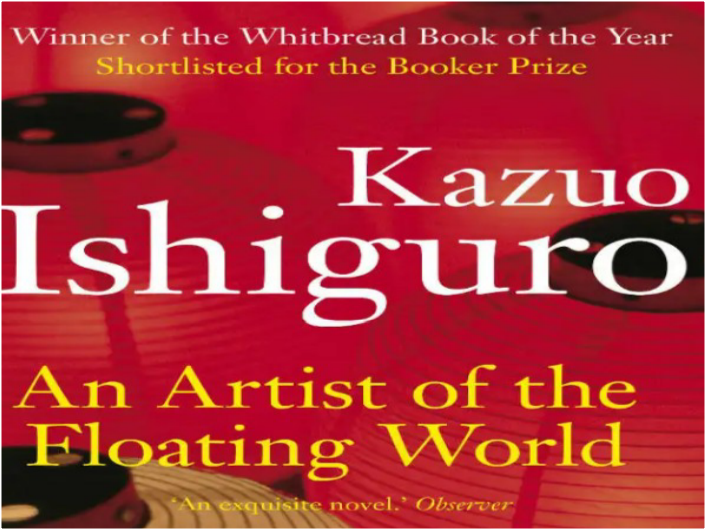A COMPREHENSIVE STUDY GUIDE TO AN ARTIST OF THE FLOATING WORLD BY KAZUO ISHIGURO
Guide book in pdf
BRIEF BIOGRAPHY OF KAZUO ISHIGURO
Kazuo Ishiguro was born in Nagasaki, Japan in 1954. He moved with his parents to Guildford in Southern England in 1960 when his father was recruited to work as a marine biologist for the British National Institute of Oceanography.
Ishiguro did not visit Japan again until he was in his thirties. Ishiguro was educated at a boys’ school in Surrey, and attended the University of Kent.
As a teen, he hoped to become a rock musician. Ishiguro received a masters at the University of East Anglia, where Angela Carter became an early mentor and he studied with Malcolm Bradbury.
Ishigura enjoyed critical acclaim starting early in his career, and won the Whitbread award for his second novel, An Artist of the Floating World.
He has been nominated for Great Britain’s most prestigious literary prize, the Booker, four times, and won it in 1989 for The Remains of the Day. In 2017, he was awarded the Nobel Prize for Literature.
The committee justified the decision to award the prize to Ishiguro by saying: “in novels of great emotional force, [Ishiguro] has uncovered the abyss beneath our illusory sense of connection with the world.” Ishiguro is married and has one daughter.
Historical Context of An Artist of the Floating World
Although the destruction and defeat of Japan during World War II give the novel its immediate context, the novel is more broadly concerned with transformations in Japanese society occurring throughout the first fifty years of the twentieth century.
In the first two decades of the century, the economy boomed as a result of modernization, industrialization, and the 1868 opening of the country’s economy to international trade. In the 1920s, the economy saw a crash, and poverty became a thorny problem, especially among peasants and industrial workers. Nationalist sentiment began to rise, with many in Japan advocating for a Japanese empire in Asia that would rival the empires of Europe. In 1931, Japan invaded Manchuria in a quest for greater resources. The war there was renewed again in 1937. Following the Japanese bombing of Pearl Harbor in 1941, Japan’s territorial possession expanded to encompass Hong Kong, the Phillipines, and other parts of Asia.
Japan then began to lose the war, but refused to surrender until long after it had become clear that the war could not be won. Nationalist propaganda advocated that ordinary Japanese citizens and soldiers make enormous sacrifices in the name of country and emperor.
The war ended with the atomic bombing of Hiroshima and Nagasaki in August 1945, although these events are never referred to in the novel. After the surrender, many Japanese were eager to move on from the devastation they had suffered.
They were extremely interested in the ideas of democracy and capitalism preached by the Americans, who occupied the country from the war’s end until 1952. In the periods during which Ono is writing his narrative, the American occupiers focused intensively on building up the Japanese economy, a historical process reflected in the changing cityscape that Ono records.
Summary of An Artist Of The Floating World
The novel begins in an unnamed city in Japan in October 1948. The narrator is Masuji Ono, a retired artist who lost both his son and wife during the war which also caused serious damage to his beautiful house.
Ono recalls the previous month’s visit of his older daughter Setsuko and her son Ichiro who live in a different town. The whole family is concerned about the marriage prospects of Ono’s younger daughter Noriko, because, a year before, Noriko had been in marriage talks with a man named Jiro Miyake when his family withdrew from negotiations under mysterious circumstances.
Noriko is currently at the start of new marriage talks with a man named Taro Saito, but at nearly twenty-six, she is considered old to be unmarried. Ono is annoyed because he feels his daughters believe he knows the real reason why the marriage negotiations broke off and is hiding it from them.
Ichiro is fascinated by a poster for a monster movie that he saw at the train station. Ono decides to take Ichiro to the movie the next day, but his daughter Noriko says she has made plans. Setsuko says that she will stay with her father the next day, and Ono and Ichiro can go see the monster movie the following day.
The next day, Setsuko says to her father that it may be wise to take precautions to prevent certain facts about his past from coming into the hands of the Saito family when they investigate the Ono family background. The day after that, Ichiro and Ono go to the monster movie.
On the way there, they run into Taro Saito’s father, who tells Ono that he has discovered they have a mutual acquaintance: Mr. Kuroda.

